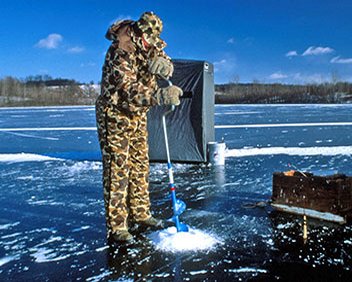Enjoy Ice-Fishing, But Be Very Cautious On the Ice

Ice-fishing is indeed a wonderful and exciting sport and a great opportunity for family members to get together and enjoy the out-of-doors. I have enjoyed ice-fishing since the 1950s. In fact, if you enjoy eating yellow perch, these fish are even more tasty when taken through the ice as compared to during open water season. But, whatever activity we do on the ice (fishing, skating, riding snowmobiles or ATVs), we need to be totally responsible and alert. We must use good judgment and observe safety precautions.

No person should ever assume that the ice thickness is the same throughout a lake, pond or river. Ice freezes first along the waters edges. Consequently, ice will be thinner as you approach the center of the body of water. River ice is weaker in general than lake or pond ice. Warm springs and/or currents will (and often do) produce areas of thin, unsafe ice. The outside of river bends, the areas along cliffs and sunny hillsides, or the points jutting out into a river, are all potential areas of ice that seem dark in color or appear “crumbly” or “honeycombed”.
A single, unbroken pressure crack in the ice is often described as, or considered to be, probably safe to cross. However, ice-users should stay away from areas where other cracks meet or intersect. You should carry a spud, ice-chisel or power-auger or an axe and test the ice thickness often as you head out toward your destination. It is advisable to have a minimum of six to seven inches of solid ice before even considering operating a snowmobile over the surface.
Unfortunately, there are still those people who think nothing of driving their car, truck or camper out onto the ice. In doing so, they greatly endanger themselves, their passengers and others who are on the ice. Driving any conventional vehicle onto the ice is foolish and very risky, mainly because of the far greater weight factors involved. Every winter, we read or hear in the news of a dozen or more vehicles going through the ice of New Hampshire lakes and ponds, some even resulting in deaths. A congregation of vehicles also puts a hefty strain on even the most solid body of ice. Ask yourself this question, is it really worth the danger of driving onto the ice with a conventional vehicle when you could walk (pulling your gear on a sled or toboggan) or using some safer means of transportation, such as a snowmobile or an ATV, that could get you there
more safely?
A snowmobiler has a better chance of escaping a sudden encounter with a pressure ridge than does someone who is driving a conventional vehicle or an ATV. That’s because the snowmobile is a lighter and quicker machine with much better traction, easier maneuverability and has more sensitivity. It is smaller in size and is spread out over less area than a conventional vehicle or an ATV. Risk for snowmobiles is also lessened because the operator is more likely to feel or sense the danger and therefore more likely to move quickly to avoid a catastrophe. However, even with these advantages, an unknowing or careless snowmobiler can get into serious trouble on the ice.
Here are some safety tips for those who will be on the ice this winter:
- Leave your car, truck or camper on
shore.
- Leave information about your plans with someone -- where you intend to fish and when you expect to return and keep them alert of any changes during your outing.
- Wear a personal floatation device and don’t fish alone.
- Ice varies in thickness. Always carry an ice spud or chisel to check the ice thickness as you proceed.
- Be extremely cautious crossing ice near river mouths, points of land, bridges, islands and over reefs and springs. Currents almost always causes ice to be thinner in these areas.
- Avoid going onto ice that has melted away from shore. This indicates melting is underway and ice can shift position as wind direction changes.
- Waves from any open water can quickly break up large areas of ice. If you can see open water in lake or pond and the wind picks up, get off immediately.
- Bring your cell phone with you.
- Carry a set of hand spikes to help you work your way out onto the surface of the ice should you go through. Hold one in each hand, then alternately punch them into the ice and pull yourself up and out. These can be purchased from stores that sell fishing supplies.
- Carry a safety line that can be thrown to someone who has gone through the ice.
- Do not build a fire on the ice at anytime.
Being prepared, let’s hope this will be a wonderful winter for ice-fishing for all. Stay safe and tight lines.

Bob Harris can be
reached via e-mail at:
outwriter2@aol.com
Past
Columns by Bob Harris
>>>
About
Bob Harris
>>>
DISCLAIMER: The opinions
expressed by Mr. Harris are not necessarily those of the
Goffstown Residents Association or its members
Copyright©2009 Goffstown Residents Association. All Rights Reserved. |





